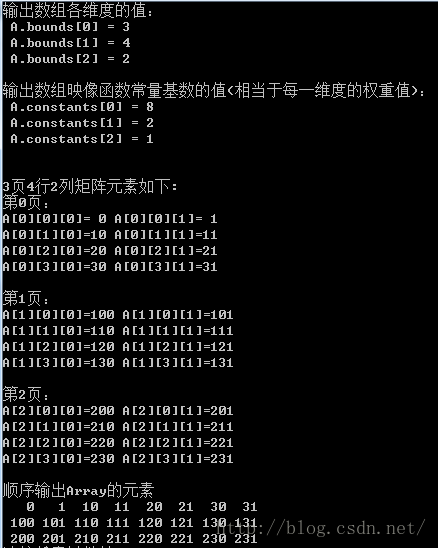以下为展示顺序数组的示例:
1.用C语言实现的版本
|
1
2
3
4
5
6
7
8
9
10
11
12
13
14
15
16
17
18
19
20
21
22
23
24
25
26
27
28
29
30
31
32
33
34
35
36
37
38
39
40
41
42
43
44
45
46
47
48
49
50
51
52
53
54
55
56
57
58
59
60
61
62
63
64
65
66
67
68
69
70
71
72
73
74
75
76
77
78
79
80
81
82
83
84
85
86
87
88
89
90
91
92
93
94
95
96
97
98
99
100
101
102
103
104
105
106
107
108
109
110
111
112
113
114
115
116
117
118
119
120
121
122
123
124
125
126
127
128
129
130
131
132
133
134
135
136
137
138
139
140
141
142
143
144
145
146
147
148
149
150
151
152
153
154
155
156
157
158
159
160
161
162
163
164
165
166
167
168
169
170
171
172
173
174
175
176
177
178
179
180
181
182
183
184
185
186
187
188
189
190
191
192
193
194
195
196
197
198
199
200
201
202
203
204
205
206
207
208
209
210
|
#include<stdio.h> /* EOF(=^Z或F6),NULL */ #include<math.h> /* floor(),ceil(),abs() */ #include<stdlib.h> /*申请和释放内存*/ #include<stdarg.h> /*可变参数*/ #define OK 1 //成功标志 #define ERROR 0 //错误标志 #define MAX_ARRAY_DIM 8 //数组最大维数 typedef int ElemType; typedef int Status; /* Status是函数的类型,其值是函数结果状态代码,如OK等 */typedef struct{ ElemType *base; /* 数组元素基址,由InitArray分配 */ int dim; /* 数组维数 */ intint *bounds; /* 数组维界基址,由InitArray分配 */ intint *constants; /* 数组映象函数常量基数,相当于每一维度的权重值,由InitArray分配 */}Array; /* 顺序存储数组的基本操作*/Status InitArray(Array *A, int dim, ...) { /* 若维数dim和各维长度合法,则构造相应的数组A,并返回OK */ int elemtotal = 1, i; /* elemtotal是元素总值 */ if (dim<1 || dim>MAX_ARRAY_DIM) //判断数组维数 { return ERROR; } (*A).dim = dim; /* 数组维数 */ (*A).bounds = (intint *)malloc(dim*sizeof(int)); /* 数组维界基址 */ if (!(*A).bounds) { exit(OVERFLOW); } va_list ap; va_start(ap, dim); for (i = 0; i < dim; ++i) { (*A).bounds[i] = va_arg(ap, int); if ((*A).bounds[i] < 0) { return UNDERFLOW; /* 在math.h中定义为4 */ } elemtotal *= (*A).bounds[i]; } va_end(ap); (*A).base = (ElemType *)malloc(elemtotal*sizeof(ElemType)); if (!(*A).base) { exit(OVERFLOW); } (*A).constants = (intint *)malloc(dim*sizeof(int)); if (!(*A).constants) { exit(OVERFLOW); } (*A).constants[dim - 1] = 1; for (i = dim - 2; i >= 0; --i) { (*A).constants[i] = (*A).bounds[i + 1] * (*A).constants[i + 1]; } return OK; } /* 销毁数组A */Status DestroyArray(Array *A) { if ((*A).base) { free((*A).base); (*A).base = NULL; } else { return ERROR; } if ((*A).bounds) { free((*A).bounds); (*A).bounds = NULL; } else { return ERROR; } if ((*A).constants) { free((*A).constants); (*A).constants = NULL; } else { return ERROR; } return OK; } /* 若ap指示的各下标值合法,则求出该元素在A中的相对地址off *//* Value()、Assign()调用此函数 */Status Locate(Array A, va_list ap, intint *off) { int i, ind; *off = 0; for (i = 0; i < A.dim; ++i) { ind = va_arg(ap, int); if (ind < 0 || ind >= A.bounds[i]) { return OVERFLOW; } *off += A.constants[i] * ind; } return OK; } /* ...依次为各维的下标值,若各下标合法,则e被赋值为A的相应的元素值 */Status Value(ElemType *e, Array A, ...) { va_list ap; Status result; int off; va_start(ap, A); if ((result = Locate(A, ap, &off)) == OVERFLOW) /* 调用Locate() */ { return result; } *e = *(A.base + off); return OK; } /* ...依次为各维的下标值,若各下标合法,则将e的值赋给A的指定的元素 */Status Assign(Array *A, ElemType e, ...) { va_list ap; Status result; int off; va_start(ap, e); if ((result = Locate(*A, ap, &off)) == OVERFLOW) /* 调用Locate() */ { return result; } *((*A).base + off) = e; return OK; } void main() { Array A; int i, j, k, *p, dim = 3, bound1 = 3, bound2 = 4, bound3 = 2; /* a[3][4][2]数组 */ ElemType e, *p1; /* 构造3*4*2的3维数组A */ InitArray(&A, dim, bound1, bound2, bound3); /* 顺序输出A.bounds */ printf("输出数组各维度的值:\n "); p = A.bounds; for (i = 0; i < dim; ++i) { printf("A.bounds[%d] = %d\n ", i, *(p + i)); } printf("\n"); /* 顺序输出A.constants */ printf("输出数组映像函数常量基数的值(相当于每一维度的权重值):\n "); p = A.constants; for (i = 0; i < dim; ++i) { printf("A.constants[%d] = %d\n ", i, *(p + i)); } printf("\n\n"); printf("%d页%d行%d列矩阵元素如下:\n", bound1, bound2, bound3); for (i = 0; i < bound1; ++i) { printf("第%d页:\n", i); for (j = 0; j < bound2; ++j) { for (k = 0; k < bound3; ++k) { Assign(&A, i * 100 + j * 10 + k, i, j, k); /* 将i*100+j*10+k赋值给A[i][j][k] */ Value(&e, A, i, j, k); /* 将A[i][j][k]的值赋给e */ printf("A[%d][%d][%d]=%2d ", i, j, k, e); /* 输出A[i][j][k] */ } printf("\n"); } printf("\n"); } p1 = A.base; printf("顺序输出Array的元素\n"); for (i = 0; i < bound1*bound2*bound3; ++i) /* 顺序输出A.base */ { printf("%4d", *(p1 + i)); //输出换行 if (i % (bound2*bound3) == (bound2*bound3 - 1)) { printf("\n"); } } /* 销毁数组A */ DestroyArray(&A); } |
运行结果如下图所示:

如有疑问请留言或者到本站社区交流讨论,感谢阅读,希望能帮助到大家,谢谢大家对本站的支持!
原文链接:http://blog.csdn.net/chinawangfei/article/details/52932212














